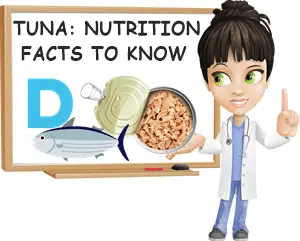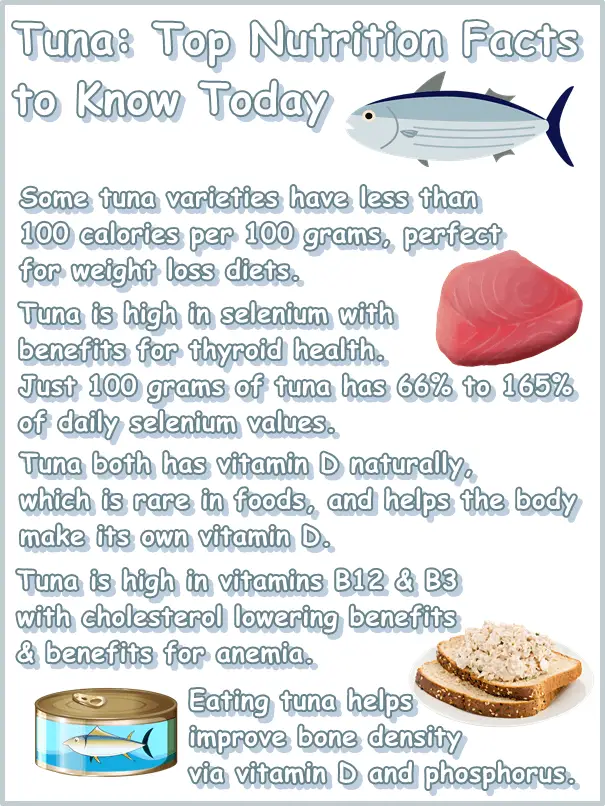Tuna is known as a healthy food and largely present in modern diets. But just how healthy is tuna? Tuna is justly classified as a nutritious food: it’s both nutritionally dense and provides a wide range of essential nutrients, from fat soluble vitamins such as vitamin D and water soluble vitamins such as vitamin B3 to macronutrients such as protein and essential fatty acids such as DHA Omega-3.
(1) Calories content: low to moderate
How many calories in tuna? Depending on the type of tuna (light, white, bluefin, skipjack, albacore, yellowfin) and how it’s processed (raw, cooked, smoked, canned in brine, in water, in oil), there are 95 kcal (kilocalories) to 245 kcal (kilocalories) per 100 grams of the fish. That makes tuna a low calorie to moderate calorie food, great for a weight loss diet.

(2) Protein content: high
How much protein in tuna? On average tuna has between 22 and 29 grams of protein per 100 grams, an excellent amount. Protein is a macronutrient, that is, an essential nutrient required in larger amounts in the diet.
The average adult requires about 50 grams of protein a day, and just 100 grams of tuna provides between 44% and 58% of total daily protein values.
Getting enough protein in your diet every day both helps maintain muscle mass and build new muscle, and provides benefits for the immune system, nervous system and health in general. For example, the amino acids that make up the protein in tuna are used by the nervous system to synthesize neurotransmitters that regulate the activity of the nervous system, including things such as sleep, appetite, mood and productivity.
(3) Vitamin D content: high
Tuna is one of the few foods that naturally have vitamin D. Not just this, but it’s also typically high in vitamin D: a serving of 100 grams of tuna provides between 33.5% to 45% of daily vitamin D values for an adult. Even better, it is a source of cholesterol which the body processes and uses to make its own vitamin D via sunlight exposure.
Find out more about the vitamin D content in tuna according to species, serving size and processing method.

(4) Vitamin B3 content: high
How much vitamin B3 in tuna? There are 15.4 mg of vitamin B3 (niacin) in 100 grams of fresh (raw) skipjack tuna. There are 18.5 mg of vitamin B3 (niacin) in 100 grams of fresh (raw) yellowfin tuna. There are 8.65 mg of vitamin B3 (niacin) in 100 grams of fresh (raw) bluefin tuna. There are 12.4 mg of vitamin B3 (niacin) in 100 grams of light tuna, canned in oil, drained solids.
The average adult needs between 14 mg of vitamin B3 (women) and 16 mg (men) every day. Just 100 grams of tuna can easily cover 50% of all of your daily vitamin B3 requirements, or close to 100%. Among its many benefits for health, vitamin B3 from tuna in the form of niacin helps keep triglycerides and LDL cholesterol levels low, and HDL cholesterol levels high.
Getting enough niacin, the form of vitamin B3 also found in tuna, from your diet activates niacin receptors throughout the body and sets in motion anti-inflammatory responses at the level of the brain, skin, blood vessels, and digestive system.
(5) Vitamin B12 content: high
Did you know that tuna is high in vitamin B12? There are 1.9 mcg (micrograms) to 9.43 mcg (micrograms) of vitamin B12 in 100 grams of tuna, depending on variety. The average adult needs 2.4 mcg of vitamin B12 per day, every day. That is, 100 grams of tuna provides 79% to almost 393% of daily vitamin B12 values for an adult.
Vitamin B12 from tuna, and cholesterol, serve as building blocks for synthesizing a protective, insulating coating called the myelin sheath. The myelin sheath surrounds the tail of nerve cells and serves to prevent electrical impulses from leaking. Loss of the myelin sheath exposing nerve cells has been linked to degenerative diseases of the nervous system such as multiple sclerosis.
(6) Phosphorus content: high
How much phosphorus in tuna? There are 222 to 311 mg (milligrams) of phosphorus per 100 grams of tuna, depending on species and processing undergone. The average adult needs 700 to 1250 mg of phosphorus per day (RDI or recommended daily intake for women and men). That would mean that just 100 grams of tuna provides between 31% and 44% of daily phosphorus values for adult women, and 17.7% and 25% of daily phosphorus values for men.
Calcium phosphates, made from both calcium and phosphorus, enter the composition of bones, and teeth, and make them hard, resilient. Phosphorus also enters the composition of tooth enamel and increases their resistance to tooth decay.
(7) Iron content: modest
How much iron in tuna? There are 1 to 1.39 mg (milligrams) of iron in 100 grams of tuna (average content). The average adult needs 18 mg (milligrams) of iron every day. That would mean that eating 100 grams of tuna can get you 5.5% to 7.7% of all the iron you need in a day.
Not just this, but tuna has a form of iron called heme-iron which is more bioavailable, meaning you are likely to absorb more iron from eating tuna than from eating spinach. To further boost absorption of iron, you can eat it together with a source of vitamin C such as oranges, orange juice, kiwifruit, strawberries or raw salad greens.
The good content of iron in tuna recommends it for consumption in iron poor diets, and for anyone with iron deficiency anemia. Iron, protein and vitamins B3 and B12 in tuna combat muscle weakness and generalized weakness, boost vitality, stamina and energy levels.
(8) Magnesium content: modest
Compared to nuts and seeds which are typically excellent sources of magnesium, tuna ranks poorly. Nonetheless, it is a reliable source of the dietary mineral, a good option for those allergic to nuts and seeds for example.
How much magnesium in tuna? There are 35 to 50 mg (milligrams) of magnesium in 100 grams of tuna. The average adult needs 420 mg (milligrams) of magnesium a day. Just 100 grams of tuna can get you a little over 8% to 12.5% of your daily magnesium requirements.
(9) Selenium content: high
How much selenium in tuna? There are 36.5 mcg (micrograms) to 90.6 mcg (micrograms) of selenium in 100 grams of tuna. The average adult needs 55 mcg of tuna per day, every day. A serving of 100 grams of tuna provides 66.66% to close to 165% of daily selenium values.
Selenium is important for health. Low levels of selenium have been associated with higher risks of prostate cancer. Selenium contributes to maintaining the health of the heart muscle, and regulates thyroid hormone production and, by extension, metabolism and endocrine functions.
(10) Source of iodine
One of the most important essential nutrients that needs to be present in the diet is iodine. Iodine is vital for a healthy thyroid and fish such as tuna, and fish and seafood in general, are the best foods to get your iodine from. Iodine regulates thyroid activity and the production of thyroid hormones which, in turn, have direct effects on physical and mental health, including metabolism and weight, and fertility in women.
(11) Source of DHA Omega-3 fatty acids
Tuna contains a form of Omega-3 known as DHA, or Docosahexaenoic acid. This form of Omega-3 occurring naturally in tuna enters the composition of the brain, as well as skin and retina. Eating tuna helps keep the brain young and supports cognitive functions such as memory and learning. Not just this, but it is a source of antioxidant and anti-inflammatory benefits for the skin, and supports eye health, with potential benefits for visual acuity.
Other forms of Omega-3 from tuna have been found to lower triglyceride and LDL cholesterol levels, and support normal brain development and cognitive functions, and lower inflammation levels in the body.
Other types of polyunsaturated fatty acids in tuna include:
- Eicosapentaenoic acid (EPA), also found in other oily fish (salmon, mackerel, sardines, herring) and fish oils (cod liver oil, sardines oil)
- Docosapentaenoic acid (DPA)
- Stearidonic acid (SDA), also found in Spirulina and blackcurrants
- Eicosatetraenoic acid (ETA),
